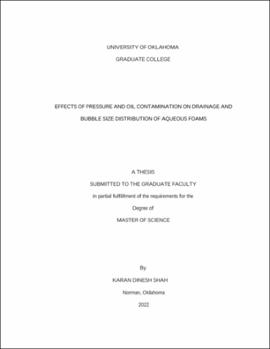| dc.description.abstract | Foams exhibit valuable properties such as high viscosity, low density, and good cutting carrying capacity. However, they are thermodynamically unstable due to gravitational drainage, bubble coalescence, and coarsening. As a result, they lose these functional properties with time. Therefore, this study investigates the effects of pressure and contaminant oil on the stability of aqueous foams. In a flow loop with a vertical drainage measurement section, nitrogen foam was generated. Drainage experiments were conducted for different (40 - 60%) foam qualities while varying the pressure from 100 to 400 psi. Water with 2% anionic surfactant was used as the base liquid. Tests were also conducted at 10% v/v oil concentration to study the effect of contamination. The foam images were captured using a viewport at regular intervals to examine bubble structure and determine the bubble size distribution with time.
At constant pressure, lower-quality aqueous foams drained faster than higher-quality aqueous foams without oil contamination. On the contrary, when 10% oil was added to the base liquid, 50% quality foam exhibited lower drainage than 40% and 60% quality foams. The stability of aqueous foams also improved considerably when the pressure was increased for each foam quality, regardless of the presence of oil.
The data from image processing showed that as the pressure increases, the bubble size decreases at a constant foam quality. Besides this, bubble size approximately linearly increased with time, demonstrating bubble coalescence and coarsening. Furthermore, the size of the bubbles grew with foam quality. It can be concluded that the increase in pressure stabilizes the aqueous foam. At a given foam quality, the lower the bubble size more stable is the foam. Contaminants like oil affect the aqueous foam's stability and bubble size. This study helps understand the effect of pressure and oil contaminants on the stability of aqueous foam at different quality. | en_US |
